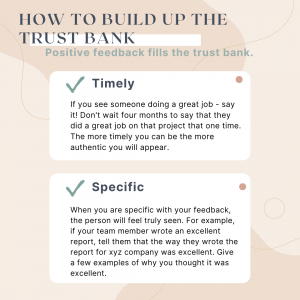How To Deal With Tricky Conversations At Work
Managing and resolving tricky conversations is part of every manager’s job. Unfortunately, this isn’t something professors teach you in school. These conversations can include anything from addressing rude behavior, to pointing out mistakes, or giving tough feedback. We end up learning these things (with much trial and error) while on the job.
 Our CEO and Founder, Jessica Chen, recently hosted a Soulcast Media | LIVE event on LinkedIn where she interviewed author, and founder of Pollack Peacebuilding Systems, Jeremy Pollack.
Our CEO and Founder, Jessica Chen, recently hosted a Soulcast Media | LIVE event on LinkedIn where she interviewed author, and founder of Pollack Peacebuilding Systems, Jeremy Pollack.
They shared key tips and personal experiences about how you can learn the exact skills to have a tricky conversation in the workplace. This Soulcast Media | LIVE event is brought to you by our amazing sponsors at Piktochart.
Piktochart is an easy-to-use visual content maker with more than 500 templates for you to choose from – ranging from infographics, presentations, reports, social media graphics, and more. Join more than 6 million people who are already using Piktochart to craft amazing visual stories.
1. Build The Trust Bank
 During the Soulcast Media | LIVE , Jeremy spoke about building a trust bank as a place to start and why it’s so important. Jeremy said your trust bank is a recorded balance of all of the positive and negative feedback you’ve given. Before you have a tricky conversation, think about how much you have built up in your trust bank with any given person. If your only interaction with someone is giving negative feedback, then the trust bank will be very low. That means any time you give feedback, it’s going to feel hostile. If the trust bank is low, you will want to start building it up. Start by giving positive feedback at least once or twice a week to build up trust.
During the Soulcast Media | LIVE , Jeremy spoke about building a trust bank as a place to start and why it’s so important. Jeremy said your trust bank is a recorded balance of all of the positive and negative feedback you’ve given. Before you have a tricky conversation, think about how much you have built up in your trust bank with any given person. If your only interaction with someone is giving negative feedback, then the trust bank will be very low. That means any time you give feedback, it’s going to feel hostile. If the trust bank is low, you will want to start building it up. Start by giving positive feedback at least once or twice a week to build up trust.
When giving positive feedback you will want it to be authentic.
- Timely – If you see someone doing a great job – say it! Don’t wait four months to say that they did a great job on that project that one time. The more timely you can be, the more authentic you will appear.
- Specific – When you are specific with your feedback, the person will feel truly seen. For example, if your team member wrote an excellent report, tell them that the way they wrote the report for xyz company was excellent. Give a few examples of why you thought it was excellent. Maybe the way they phrased certain points really drove it home. Whatever it is being specific is so important.
The more you have built up in the trust bank, the easier a tricky conversation will be. In this way, the person you are speaking to will know that you aren’t coming from a place of hostility, but rather a place of true collaboration.
Being authentic when you engage with your team is so important.
2. Your Approach
When you have to engage in a tricky conversation, it is important that you think about your approach. In other words, how will you be starting this conversation? In order to avoid more conflict, consider these strategies when approaching your next tricky conversation.
- Be Honest – Sometimes being very vulnerable can help diffuse any tension that might lead up to a tough conversation. This means you can say hey, I’m really nervous talking to you about this. Being honest and vulnerable will help set the tone for the conversation and both parties will be less likely to get defensive.
- Sandwich Method – The sandwich method, is a way to approach a tricky conversation with positivity. The sandwich method starts with saying something positive about the person or their work. Then, following the positive up with the improvement, feedback, or tricky conversation bit. And then ending on a positive note. This is especially useful when you have to give negative feedback to a team member.
- Diffuse A Defensive Reaction – Think about why someone would get defensive based on what you are about to say. And start with a positive that would directly address and counteract that. For example, if you are speaking to your manager about the way they manage, they will probably get defensive right away. However, if you frame your approach by starting off by saying – “I think you’re a really great manager,” then their defenses will go down as you have addressed their concern right away. Yes, it is ok to also give your manager feedback, but approach matter!
- Ask How To Approach – If you are dealing with someone that seems impossible to communicate with, consider asking them how to best approach a conversation with them. It’s best to ask them this before things are tense. For example, you can say, “What would be the right way to approach talking to you about ABC in the future?” The key is to get them to collaborate with you on how to approach them.
Remember, you want to have a constructive conversation, even if it is a tough one. So focus on your approach to the situation. Put yourself in the other person’s shoes. If you would get defensive, they probably would too. Soften your approach if necessary.
3. Constant Mistakes
During the Soulcast Media | LIVE, a question came from the viewers about how to give feedback to someone who is always making mistakes. Jeremy shared his take on what to do if you find yourself in that situation.
First, is there clarity because what you might be perceiving as a mistake they might not be recognizing as one. If there is clarity then consider the following strategies:
- Set Expectations – Does the person know what the expectations are? If not, make sure they are clear and that you are both on the same page.
- Acknowledgment – If the expectations are clear and they know what to expect, are they acknowledging their mistakes? If so, how can you support them so that they don’t continue to make those mistakes? If they aren’t, then maybe it’s time to reset expectations. You may have to be very specific even granular about what those expectations are, and exactly what a mistake looks like.
- Support – If you believe they are in the right role and you believe that this person is capable of the job, then you need to collaboratively figure out how you can support them in this role so that they aren’t continually making these mistakes.
- Collaborate on a solution – Give them your ideas and ask them what they think. Make them feel empowered to be accountable in the future.
You will also need to do a cost analysis on keeping this person in their role. This is a tricky (and honest) conversation that you will have to have if mistakes are still happening.

4. Care And Solution
Sometimes tricky conversations can lead to uncomfortable situations in the workplace. During the Soulcast Media | LIVE event, a viewer asked a question about what to do if someone starts to cry while you are giving them feedback. Jeremy shared his thoughts on this and his strategy – care and solution.
- Put aside the topic of conversation and just be there for the person. Just care for the person.
- Ask them what they are thinking or experiencing or what is going through their head.
- Ask if they would prefer to have this conversation at a later date.
- Be sure to check in and ask how they’re doing – another great way to build up the trust bank.
If you want to resolve conflict with someone, do what you can to care for the individual first.
When having a tricky conversation it is important to care for the person first. You can do this by:
- Listening
- Reassuring them
- Being transparent about your behavior
If you care for the person first, they will feel seen and heard. Then you can tackle problem-solving and solutions. If you go straight into solutions – it usually ends with people not feeling heard. It makes people feel like you didn’t truly understand what the problem was.
Remember, the key to having tough or tricky conversations, is to build up your trust bank. Be sure you are careful with your approach, and that you are being honest and transparent. The more you care for the individual first, the less defensive they will be.
If you would like to see the full LIVE version of Jessica and Jeremy’s conversation, check out Jessica’s Youtube Channel.
__
Whenever you’re ready, there are 3 ways we can help you:
- Discover your communications style so you know where to start. Over 4,000 people have found theirs here.
- Attend our monthly communication workshop to build communications confidence (new topics: public speaking, advocating for yourself, building credibility, etc) here.
- Get your brand in front of 43k+ people by sponsoring our newsletter or Soulcast Media | LIVE LinkedIn events [contact: hello@soulcastmedia.com]











